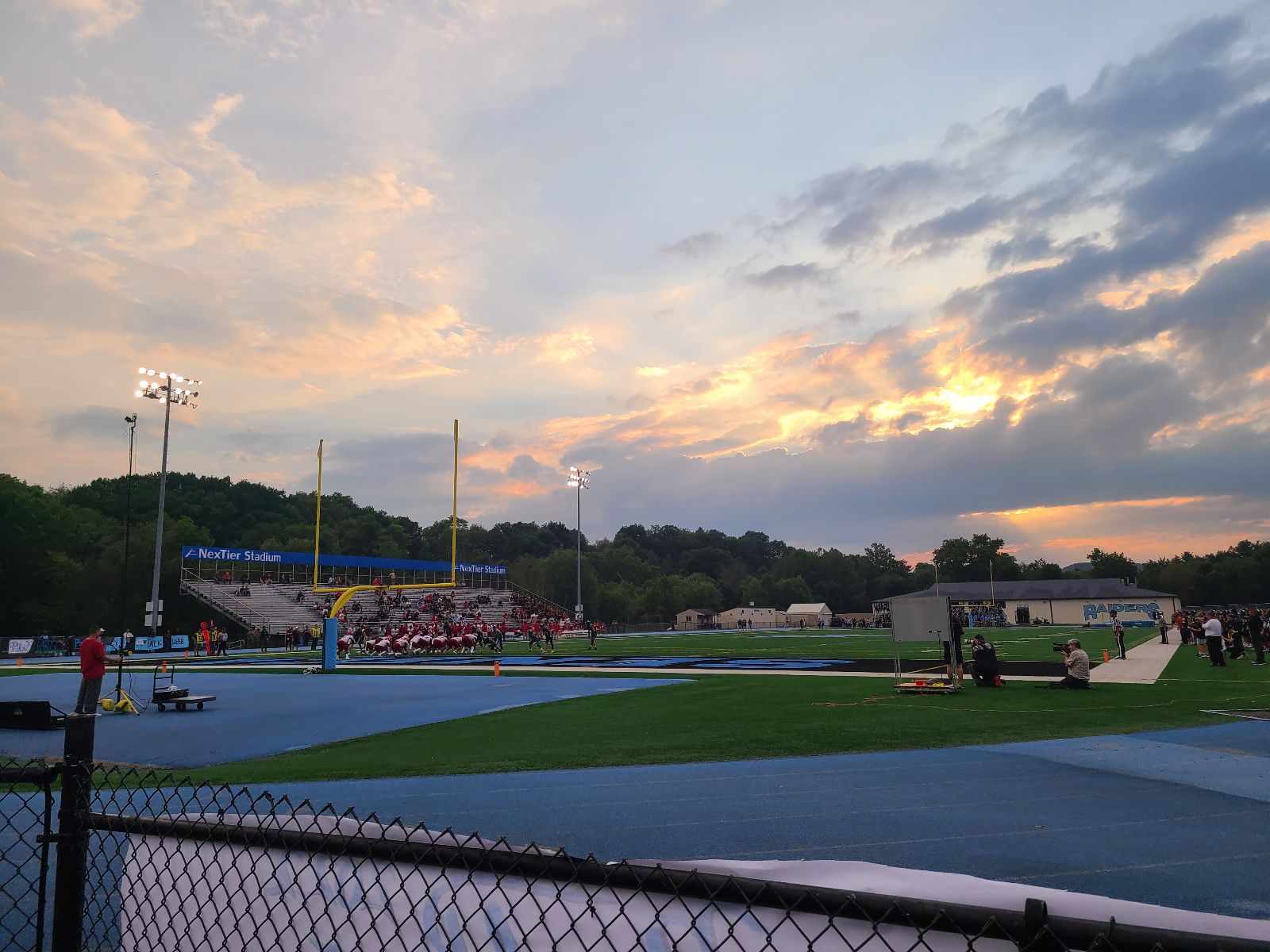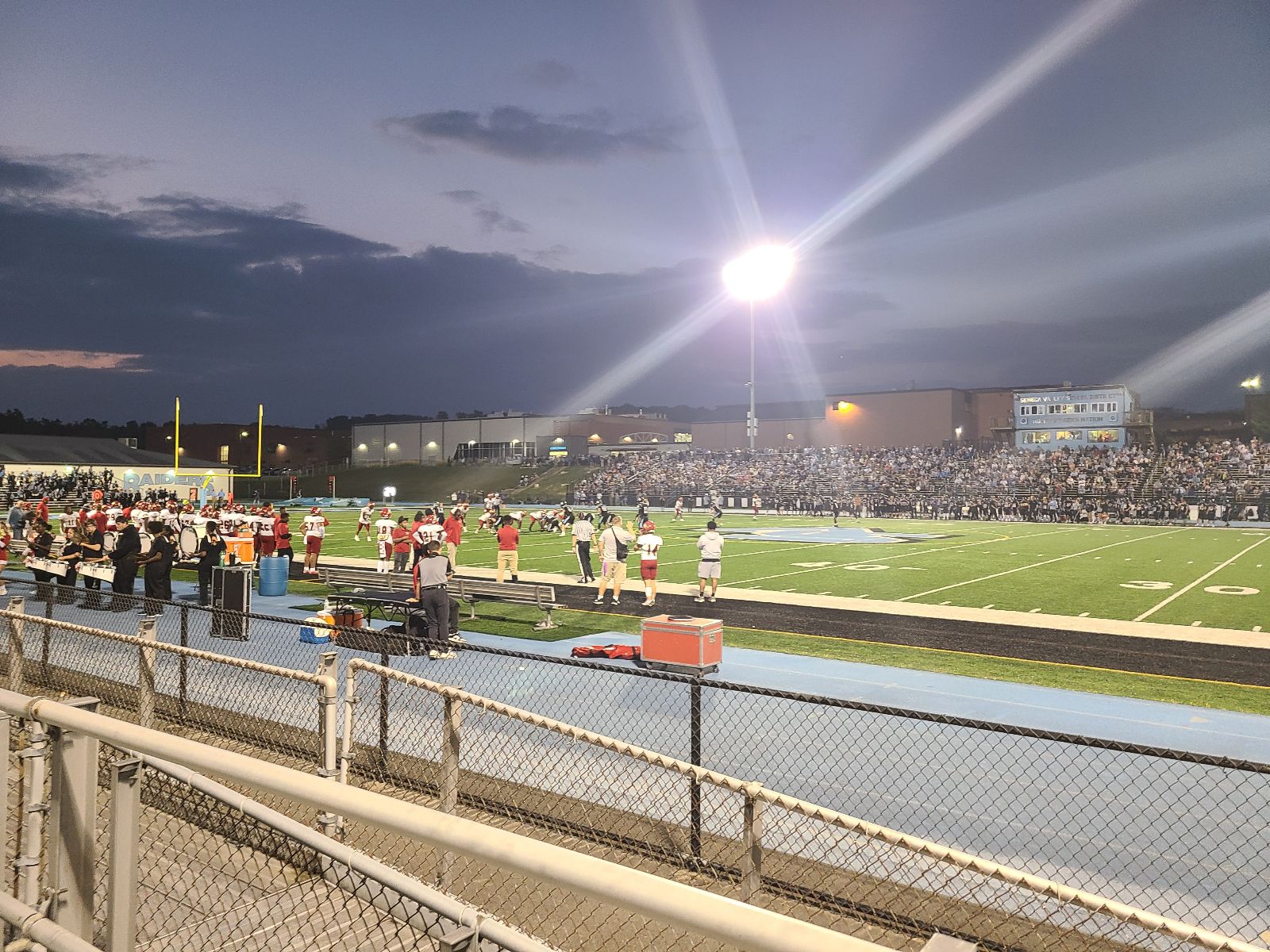Most of our WPIAL coverage on Steel City Blitz is objective coverage, discussing standings, playoff scenarios, and Games of the Week. This project is be something a little different – a first-person account of my family visiting different towns and stadiums throughout Western Pennsylvania. Two years ago I started the Tour of the WPIAL with visits to Rochester, Southmoreland, and West Greene. Unfortunately we weren’t able to make any visits in 2020 due to the COVID pandemic, but with fans allowed back in attendance last year, the Tour continued! We were able to visit Sto-Rox, Laurel, and Belle Vernon. This year we are hoping to get some more games in and kicked off the 2022 season with a trip to Seneca Valley!
 Seneca Valley
Seneca Valley
Nickname: Raiders
WPIAL Championships: 0 (0-3 in WPIAL Championship Games)
Municipalities: Callery Borough, Cranberry Twp, Evans City Borough, Forward Twp, Harmony Borough, Jackson Twp, Lancaster Twp, Seven Fields Borough, Zelienople Borough
Town History
Currently, the most developed area of the district is in Cranberry Township, but this was not always the case. Cranberry got its name from the wild cranberries that grew along Brush Creek. Unfortunately the Township had lost all of its namesake fruit by the 1880s due to the conversion of land to agricultural purposes. Cranberry was chartered in 1804 with its boundaries redrawn in 1854. Due to the water supplies and animal life, several Native American tribes spent time on the land for hunting and gathering but no evidence of long-term settlements have been found. The first European settlers were Matthew and William Graham in 1796 who acquired land through Ben Franklin’s Depreciation Land Program. The program gave Revolutionary War veterans land instead of money in repayment for their service. Cranberry maintained its agricultural heritage until the 1950s when the Pennsylvania Turnpike was completed and connected to Route 19. The 1960s brought more connectivity with the construction of I-79 and later I-279 (in 1989) provided a direct connection to Pittsburgh. These major access roads converging in Cranberry have created an ideal location for major retail, office, and industrial activity. Cranberry has boomed into a “second city” to the north of Pittsburgh and a vast majority of the agricultural land has now been taken over by commercial, industrial, and residential development.
Around the same time development was taking off in Cranberry, the adjacent Borough of Seven Fields was incorporated. What had traditionally been farmland had been sold for development in the 1970s and the developer of townhouses seceded from Cranberry Township, incorporating as the Borough of Seven Fields. Though the developer went bankrupt a few years later, the Seven Fields Development Company created a community master plan, allocating land for future development uses. Seven Fields has seen additional investment spillover from Cranberry in both commercial and residential developments.
North of Cranberry is Jackson Township, one of the first areas in the region to be settled by Europeans. The first known settler was James Magee from Ireland in 1769. The township was formally established in 1854 as a result of the redivision of Butler County into 33 townships of about 24 square miles each. The township was named for Andrew Jackson who had recently ended his term as president of the United States. To the east is Forward Township, which was first settled by Peter McKinney after the French and Indian War, who established a farm on the Connoquenessing Creek. Many sources name Peter’s daughter Elizabeth as the first European child born in Butler County. To the north of Jackson Township is Lancaster Township, which was also officially formed in 1854 with the subdivision of Butler County. Like Cranberry, Lancaster was similarly settled as Depreciation Lands after the Revolutionary War. The first known settler was Henry Beighle in 1796 and most of the early settlers were of German and Scotch-Irish descent. Much of Jackson, Forward, and Lancaster townships remain rural and agricultural today as the development from Cranberry has yet to spread northward.
Harmony Society
The Harmony Society was a pietist group of Lutheranism started in Wurttemberg, Germany. The group moved to the Butler County region in the early 1800s, led by George Rapp. The Society members shared common goods and established three “model communities.” The first became Harmony Borough in western Jackson Township. The Harmonists, as they were known, were zealous in their religious practices. The Society set up additional settlements in what would become the state of Indiana and in Beaver County which would become the Old Economy Village along the Ohio River.
Zelienople
The Borough of Zelienople was also formed out of Jackson Township in 1840. The town was laid out by German Baron Detmar Basse who named it after his daughter Zelie. Baron Basse first came to the area in 1802 and sold some of his land to George Rapp and the Harmonist Society. The town grew in the first half of the ninteenth century and expansion came rapidly after a railroad was built through Zelienople in 1878. In 1980 Zelienople was linked to New Castle, Butler and Pittsburgh by a trolley line.
Evans City
Evans City was originally named Boggs Mills after Robert Boggs who settled in the area in 1800. Boggs came north from Allegheny County and established a farm along Breakneck Creek and was also a millwright. The town was laid out in 1882 by surveyor William Purviance under contract of Thomas Evans, who had purchased land from the Boggs estate. Evans was also a millwright and his name was used for the establishment of the Borough.
One of the most famous stories of the Seneca Valley region regards George Washington. In 1753 Washington passed through the region along the Venango Trail en route to Fort LeBoeuf. His message to the French would be rejected, ultimately leading to the French and Indian War. The famous story took place on December 27, 1753 when Washington’s Native American guide turned and fired on him and his companion Christopher Gist. While the exact location of this assassination attempt is unknown, the area between Zelienople and Evans City became loosely known as “Murdering Town” and a historical marker along Route 68 near Evans City describes the encounter. Multiple municipalities in the area have held events commemorating Washington’s brush with death.
Football History
Seneca Valley was formed by the merger of Evans City and Zelienople into the Southwest Butler County School District in 1957, though the unification did not actually take place until 1964. Historically, education was provided through one-room school houses which were not consolidated into elementary schools until the 1950s. The campus where the middle, intermediate, and high school currently sit was originally built as Evans City High School in 1938. Evans City had fielded a high school football team since 1913 and competed in the WPIAL since 1924. They had perfect seasons in 1947 and 1957 but did not compete for WPIAL titles in either year.
Zelienople fielded a football team in 1908 then sporadically over the next decade. The Golden Bears also played in 1914, 1915, and 1919 before finally stabilizing in 1921. Zelienople joined the WPIAL in 1926 and would have a successful 38-year run that finished with a winning record overall of 166-135-39. Zelienople’s most successful year was in 1952 when they were selected to play a semifinal against Carmichaels, which they lost 40-14. Carmichaels would defeat Wilmerding to win the WPIAL Class B Championship that season.
In the early 1960s, a committee of students was formed to discuss a new name and mascot for the unified district. Due to the rich Native American history of the region and the portions of the Venango Trail running through the area, the name “Seneca Valley” was chosen. Seneca Valley High School opened in 1964, combining Evans City and Zelienople High Schools. The groundbreaking ceremony for the school two years earlier was attended by a Seneca chief from New York along with several others representing the Native American tribe. While the high school bore the name “Seneca Valley,” it was not until 1987 that the district itself changed the name from “Southwest Butler County School District” to “Seneca Valley School District.”
Seneca Valley competed in WPIAL football from its first year of 1964 onwards. The first record of the Raiders playing in a conference came in 1967 in the Class A Midwestern Athletic Conference (Note: Class A would become AA in 1973). Seneca Valley has never had an undefeated regular season, but won conference titles in 1989 (shared with Aliquippa and Montour), 1995, and 1997. The 1989 season was the first time Seneca Valley had qualified for the playoffs and they made a run to the WPIAL title game where they fell to conference rival Aliquippa 17-9. The 1995 and 1997 seasons both ended in the semifinals at the hands of Upper St Clair. The Raiders would make it back to the WPIAL Championship Game twice in three years after the realignment to six classifications. In 2016 they beat Mt. Lebanon in a first round shootout (49-43) then upset neighboring rival North Allegheny 28-27 by blocking an extra point as time expired that would have sent the game to overtime. Seneca Valley fell to Central Catholic 42-7 in the WPIAL final. Two years later, the Raiders got their revenge, topping Central 15-14 in the opening round – the only time since 2012 Central did not reach the WPIAL finals. Seneca Valley would once again upset North Allegheny (who were the undefeated regular season champs) and make it back to the WPIAL title game. For the third time in school history, the Raiders came up short with a 34-7 defeat by Pine-Richland.
Our Visit
Zelienople Community Park
There are a number of great family parks spread throughout the Seneca Valley School District area, so picking one to visit was difficult. Ultimately, we chose the Zelienople Community Park for its proximity to the school campus and stadium. The water fountain in the park was shaped like a lion’s head with a nice tribute to the town’s namesake.
On the whole, the park has baseball fields, a swimming pool, a skate park, a playground area, a gazebo and numerous other assets. It is a great little gem with plenty of tree cover and shade. The park has a number of different play areas and climbing arrays, which are great for kids of all ages. Even when kids of a younger age want to try their hand at one of the “big kids” climbing sets.
…or play equipment for smaller kids that the bigger ones can turn into a climbing/balancing apparatus.
 All in all, it was a great park for the kids to run around and get some steam out before we hopped in the car and took a short drive through the quaint little town of Zelienople and over the highway to get to the Seneca Valley school campus for the game.
All in all, it was a great park for the kids to run around and get some steam out before we hopped in the car and took a short drive through the quaint little town of Zelienople and over the highway to get to the Seneca Valley school campus for the game.
Seneca Valley vs Penn Hills
Seneca Valley’s stadium is located on the southern end of their high school campus, which is bounded on three sides by the Little Connoquenessing Creek, a tributary to the Connoquenessing Creek. The campus features a middle school, intermediate school, and senior high school. NexTier Stadium is the first field we have visited that has a corporate sponsor as its namesake.
For the game, Seneca Valley came in with one of their best teams in school history. They have a returning starter at quarterback in Graham Hancox who has a great arm, and three players that have committed to D1 schools. Toledo-commit Chris Dappolonia was all over the field defensively and came up with several key plays to end Penn Hills drives. The Raiders also have two players headed to the Naval Academy in Aiden Lyczek and Luke Lawson.
Seneca Valley dominated the first half. They controlled the ball and the clock, but couldn’t put a lot of points on the board. Penn Hills defense came up with a 4th down stop in the red zone but couldn’t get anything going on offense and were pinned with their backs against the goal line the whole first half. Seneca Valley would break the ice with Hancox hitting Navy-commit Luke Lawson on a slant route for a touchdown. Seneca Valley went for two but was unsuccessful, keeping the score at 6-0. Penn Hills fumbled the ensuing kickoff and Seneca Valley would capitalize on the turnover, making it 9-0.
The last minute of the first half proved to be a wild one. With Penn Hills still stuck in their own end and backed up by penalties, Seneca Valley would use their timeouts to force a 4th down punt with 10 seconds left. Penn Hills snapped the ball over their punter’s head, and with rushers closing in, he turned around and kicked the ball out of the back of the end zone. Seneca Valley had the option to have first and goal at the 3 with 3 seconds left, or take the safety. They took the two points and went into halftime up 11-0.
In the second half, the script was flipped almost entirely. Penn Hills with highly-touted junior Julian Dugger at quarterback, found their legs offensively. The Indians took their first drive and took it down for a field goal to cut the lead to 11-3. On their next drive, running back Amir Key finally found a hole and scampered for a 53-yard touchdown. Seneca Valley blocked the extra point to hold on to an 11-9 lead. Key would score again at the outset of the fourth quarter but Seneca Valley once again blocked the extra point, giving Penn Hills a 15-11 lead.
Graham Hancox took over from there, leading Seneca Valley’s offense back down the field. Hancox capped off a four-minute drive with a 4-yard QB keeper to put the Raiders back on top. They missed the extra point, making the margin 17-15. The teams would trade possessions and Penn Hills would have the ball in the final minute with Dugger having the chance for heroics. The Indians got into the red zone but missed a 34-yard field goal as time expired that would have given them the win. Ultimately, Seneca Valley’s election to take the 2-point safety at the end of the first half (or the two extra points they blocked) made up the decisive margin in the game. Both of these teams are loaded with talent and are primed for big things this season.
Conclusion
Seneca Valley has grown into one of the largest school districts in the WPIAL. The community support for the football team was great. The stands were absolutely PACKED on the home side and the student section was loud and raucous. As a cool touch to the stadium, they had a separate section for the band that was behind the western end zone. This enabled the sound of their massive band to fill the stadium, rather than having them at one end of the bleachers like many schools do. The band put on a great halftime performance as well. Given the size of the crowd and the growing nature of the district, Seneca Valley may need to invest in additional seating at their stadium in the coming years. One of the unique features was the light blue track, which complemented the color scheme of the black end zones with blue lettering. With the trio of D1 recruits and a number of other talented players, this may be Seneca Valley’s best team in school history. They went toe-to-toe with a good Penn Hills team and were able to pull out the victory with a fourth quarter touchdown when they needed it most. All in all, we had a fun trip to kick off the 2022 season!







